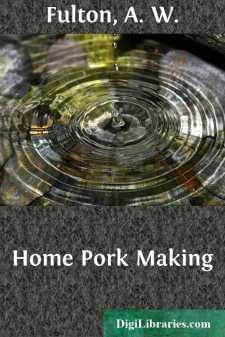Categories
- Antiques & Collectibles 13
- Architecture 36
- Art 48
- Bibles 22
- Biography & Autobiography 813
- Body, Mind & Spirit 142
- Business & Economics 28
- Children's Books 17
- Children's Fiction 14
- Computers 4
- Cooking 94
- Crafts & Hobbies 4
- Drama 346
- Education 46
- Family & Relationships 57
- Fiction 11829
- Games 19
- Gardening 17
- Health & Fitness 34
- History 1377
- House & Home 1
- Humor 147
- Juvenile Fiction 1873
- Juvenile Nonfiction 202
- Language Arts & Disciplines 88
- Law 16
- Literary Collections 686
- Literary Criticism 179
- Mathematics 13
- Medical 41
- Music 40
- Nature 179
- Non-Classifiable 1768
- Performing Arts 7
- Periodicals 1453
- Philosophy 64
- Photography 2
- Poetry 896
- Political Science 203
- Psychology 42
- Reference 154
- Religion 513
- Science 126
- Self-Help 84
- Social Science 81
- Sports & Recreation 34
- Study Aids 3
- Technology & Engineering 59
- Transportation 23
- Travel 463
- True Crime 29
Home Pork Making
by: A. W. Fulton
Description:
Excerpt
INTRODUCTION.
Hog killing and pork making on the farm have become almost lost arts in these days of mammoth packing establishments which handle such enormous numbers of swine at all seasons of the year. Yet the progressive farmer of to-day should not only provide his own fresh and cured pork for family use, but also should be able to supply at remunerative prices such persons in his neighborhood as appreciate the excellence and general merit of country or “homemade” pork product. This is true, also, though naturally in a less degree, of the townsman who fattens one or two pigs on the family kitchen slops, adding sufficient grain ration to finish off the pork for autumn slaughter.
The only popular book of the kind ever published, “Home Pork Making” furnishes in a plain manner just such detailed information as is needed to enable the farmer, feeder, or country butcher to successfully and economically slaughter his own hogs and cure his own pork. All stages of the work are fully presented, so that even without experience or special equipment any intelligent person can readily follow the instructions. Hints are given about finishing off hogs for bacon, hams, etc. Then, beginning with proper methods of slaughtering, the various processes are clearly presented, including every needful detail from the scalding vat to the kitchen baking dish and dining-room table.
The various chapters treat successively of the following, among other branches of the art of pork making: Possibilities of profit in home curing and marketing pork; finishing off hogs for bacon; class of rations best adapted, flesh and fat forming foods; best methods of slaughtering hogs, with necessary adjuncts for this preliminary work; scalding and scraping; the construction of vats; dressing the carcass; cooling and cutting up the meat; best disposition of the offal; the making of sausage and scrapple; success in producing a fine quality of lard and the proper care of it.
Several chapters are devoted to putting down and curing the different cuts of meat in a variety of ways for many purposes. Here will be found the prized recipes and secret processes employed in making the popular pork specialties for which England, Virginia, Kentucky, New England and other sections are noted. Many of these points involve the old and well-guarded methods upon which more than one fortune has been made, as well as the newest and latest ideas for curing pork and utilizing its products. Among these the subject of pickling and barreling is thoroughly treated, renewing pork brine; care of barrels, etc. The proper curing of hams and shoulders receives minute attention, and so with the work of dry salting bacon and sides. A chapter devoted to smoking and smokehouses affords all necessary light on this important subject, including a number of helpful illustrations; success in keeping bacon and hams is fully described, together with many other features of the work of home curing. The concluding portion of the book affords many interesting details relating to the various cuts of meat in the big packing houses, magnitude of the swine industry and figures covering the importance of our home and foreign trade in pork and pork product.
In completing this preface, descriptive of the various features of the book, the editor wishes to give credit to our friends who have added to its value through various contributions and courtesies. A considerable part of the chapters giving practical directions for cutting and curing pork are the results of the actual experience of B. W. Jones of Virginia; we desire also to give due credit to contributions by P. H. Hartwell, Rufus B. Martin, Henry Stewart and many other practical farmers; to Hately Brothers, leading packers at Chicago; North Packing and Provision Co. of Boston, and to a host of intelligent women on American farms, who, through their practical experience in the art of cooking, have furnished us with many admirable recipes for preparing and serving pork.
PORK MAKING ON THE FARM.
During the marvelous growth of the packing industry the past generation, methods of slaughtering and handling pork have undergone an entire revolution. In the days of our fathers, annual hog-killing time was as much an event in the family as the harvesting of grain. With the coming of good vigorous frosts and cold weather, reached in the Northern states usually in November, every farmer would kill one, two or more hogs for home consumption, and frequently a considerable number for distribution through regular market channels....


